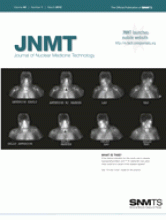Abstract
The steam-sterilized 18F-FDG of our laboratory frequently has a pH of around 6.5. To avoid decomposition, we studied the possibility of adjusting the pH by adding a pharmaceutical compound but without modifying the usual production sequence and reagents. Methods: Citric acid in 4 concentrations (0.01, 0.03, 0.05, and 0.06 M) was added to routine batches of 18F-FDG. Established pharmacopeia quality controls at 0 and 12 h after synthesis were run, and the dilution effect was checked. Results: A 0.06 M concentration of 1:15 v/v citric acid brought about a pH range of 5.46–5.68; did not change significantly after 1/10 dilution; and did not interfere with quality control. The results of quality control 12 h after dispensing were in the desired range. Conclusion: A 0.06 M concentration of 1:15 v/v citric acid modifies pH in a buffered 18F-FDG solution without the need to change the synthesizer protocol or reagent composition. This new formulation allows pH adjustment; is an easy, reliable, and safe method with no technical difficulties; and does not interfere with the quality of the radiopharmaceutical.
Temperature, pH, and specific volume play an important role in 18F-FDG stability. Impurities from epimerization and hydrolysis have been observed at a more alkaline pH (1). The rate of decomposition due to steam sterilization is diminished in an acidic environment, and radiolysis of high-activity 18F-FDG solutions is significantly lower at pH 5.5 than at a neutral pH. pH 5.5 appears to be optimal and gives 18F-FDG of high radiochemical purity (∼99%) (2).
The steam-sterilized citrate-buffered 18F-FDG solution synthesized in a commercial module in our laboratory repeatedly shows a pH higher than 6.5, with the presence of undesirable 18F-fluorodeoxymannose. We proposed to adjust the pH closer to 5.5 by adding citric acid to 18F-FDG before sterilization by heat, without modifying the synthesis sequence and reagent composition.
Citric acid monohydrate (reagent specification as per the European Pharmacopoeia; Merck) was chosen because of the reagent composition of the TRACERlab MX synthesizer (GE Medical Systems) (buffer vial contains disodium hydrogen citrate-1,5-hydrate and trisodium citrate-2-hydrate; ABX Advanced Biochemical Compounds), its acidity and dissociation constants (pH 2.2 in 0.1N solution; pKa1 = 3.09, pKa2 = 4.75 (3), where pKa is the negative logarithm of the acid dissociation constant), and its recognition as an excipient in pharmacopeias (4,5).
MATERIALS AND METHODS
Citric acid monohydrate in 0.01, 0.03, 0.05, and 0.06 M solution was added in various ratios to three 18F-FDG solutions with pH higher than 6.5 (1:1, 1:15, 1:30, and 1:60 citric acid:18F-FDG [v/v] [30.00–0.16 mM]). pH was tested in all cases (pH meter 3520 [Jenway], with a glass electrode).
The use of 1:15 v/v citric acid in 0.03 M (n = 10), 0.05 M (n = 10), and 0.06 M (n = 10) concentrations was studied in 30 batches of 18F-FDG (2,600–4,000 MBq/mL), and pharmacopeia quality controls were run in all cases.
RESULTS
18F-FDG at 1:1 v/v reached a pH lower than 5.5 (pH 4 ± 1) for the 4 chosen concentrations. A 0.01 M concentration of 1:15, 1:30, and 1:60 v/v citric acid did not decrease pH enough (6.20 ± 0.10). However, 0.03, 0.05, and 0.06 M concentrations of 1:15 v/v citric acid brought about suitable pH values, as indicated in Table 1.
pH of 18F-FDG with Citric Acid Added
In routine batch production, the addition of a 0.06 M concentration of 1:15 v/v citric acid produced a pH range of 5.46–5.68, a 0.05 M concentration produced a pH range of 5.51–6.22, and a 0.03 M concentration produced a pH range of 5.68–6.52. Pharmacopeia quality controls had results similar to those for 18FDG with no citric acid added (Table 2).
Data of Formulation Tested in 18F-FDG Routine Production
Dilution with physiologic saline to at least 1/10 was well tolerated.
pH, 18F-FDG, and free 18F-fluoride met pharmacopeia requirements 12 h after dispensing.
DISCUSSION
Formulation with a 0.06 M concentration of 1:15 v/v citric acid produced pH values closer to 5.5 in batches of 18F-FDG ranging from 2,600 to 4,000 MBq/mL. Dilution with physiologic saline to at least 1/10 was well tolerated, but batches of higher activity should be tested.
To avoid degradation, the use of some acidic species is common in the formulation (2,6,7), but differences in formulation can have a profound effect on the radiochemical purity of 18F-FDG (8). In our case, pharmacopeia quality controls showed results similar to those of 18F-FDG with no citric acid added. Therefore, the substance did not interfere in quality tests (endotoxin test included; no inhibition was detected). The new formulation retained radiochemical purity for at least 12 h.
CONCLUSION
This new formulation can be considered acceptable for routine production. It is an easy, reliable, and safe way to adjust the pH of 18F-FDG produced in a TRACERlab MX synthesizer, without changing the cassette and reagent composition.
Acknowledgments
No potential conflict of interest relevant to this article was reported.
Footnotes
Published online Jan. 25, 2012.
REFERENCES
- Received for publication May 10, 2011.
- Accepted for publication September 15, 2011.







